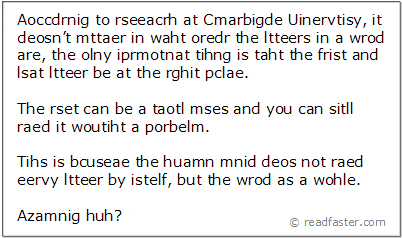Have you ever been in a group watching a PowerPoint presentation and felt like the presenter was switching slides too quickly- or that maybe everyone around you was reading at a much faster speed than you? While you may have felt left out, be rest assured that you probably had more company than you thought.
While your reading speed will vary with the content of the material presented, according to Staples, the average person reads 300 words a minute. Many factors will influence your reading speed outcome such as mood, lighting, and overall environment. If you are curious to know your reading speed, take the eReader test from Staples here.
As you may recall, growing up we were subject to many myths about reading. Some of the more popular myths included:
Reading every letter makes you a better reader
The human brain is wired to process words, first and foremost, for understanding rather than for grammatical accuracy. This means that when reading, our brain’s first goal is to understand the meaning of the word and the context of a sentence. For further proof, try reading the following text:
Slow reading brings more enjoyment
While this myth may easily be defied by most school-aged children, it is important to note that slowing your pace will not alter the content of your reading material. However, speed reading material that is of high interest to you will enable your brain to vividly picture the scenes from the text and thus create a much more rewarding experience for the reader.
Here are some easy ways to help you save time when reading, while maintaining your comprehension:
1. Selectively skim the text
This PsycNet study by H.Y. McClusky shows that contrary to the belief that every word must be read to understand a text, preliminary skimming can help save time when reading. However, you must do so appropriately in order to understand the message conveyed in the text. For example, it is highly recommended to always read the introduction and the conclusion of a text to ensure that the context of the material is not lost. Moreover, when reading a memorandum, you will need to ensure you read the subject line and first lines of the memo to understand the subject. Furthermore, reading the final paragraph of the memo will reiterate the points you skimmed over.
2. Use a pointer
While you may initially feel like you have reverted back to preschool, over time, you will learn to appreciate having a visual aid to help you keep track of your eye placement while reading a text. According to Mindtools.com, the use of a pointer forces your eyes and brain to keep a more focused pace. Try to read this paragraph from the beginning and use your index finger as a pointer, you will notice that your eyes will focus on the last line above your finger and the speed at which you move your finger will set your reading pace.
3. Have a purpose
According to the National Council of Teachers of English, setting authentic purposes for reading will pique curiosity and prepare the mind for the information that it is about to receive. Whether it is for information or simply relaxation, try to have a purpose for reading the material at hand. Whether it is a required report for your next staff meeting or a whole chapter for next week’s history test, subconsciously this process will help to prepare your brain for the activity and thus accelerate comprehension.
4. Read for enjoyment
We are always more motivated to do something that we care about and it is no different with reading. Unlike what most may assume, slow readers do not dread reading, they simply may not have found something that piqued their interest. When reading, try to find topics that are of high interest to you and it will help the process. Your interest in the topic will make it much easier as your brain will quickly register the words. A 2012 study from the United Kingdom’s Department of Education shows that reading for enjoyment not only increased writing ability, text comprehension, and grammar but it also promoted greater self-confidence as a reader. Even with topics that tend to be tedious such as a lease agreements, putting a positive spin on the task will help your brain complete the process effectively. As they say, ‘practice makes perfect’; hence, your reading speed may not be as fast as it would when reading something truly interesting, but having a positive mind will help.
Becoming a speed reader will not occur overnight, however with practice, you can become a quicker reader.
Featured photo credit: Reading Glasses on Book with Hot Tea Drink/ Ed Gregory via stokpic.com













































